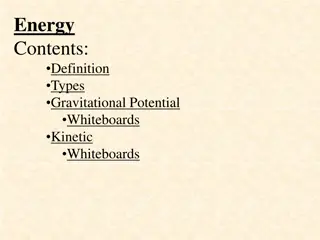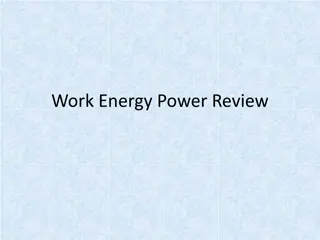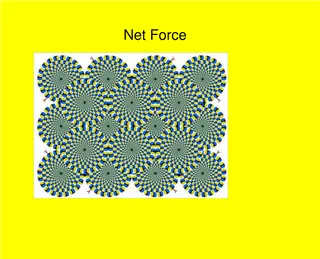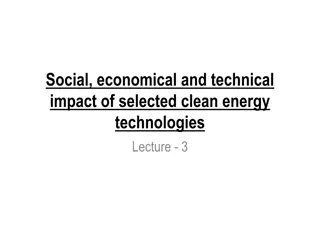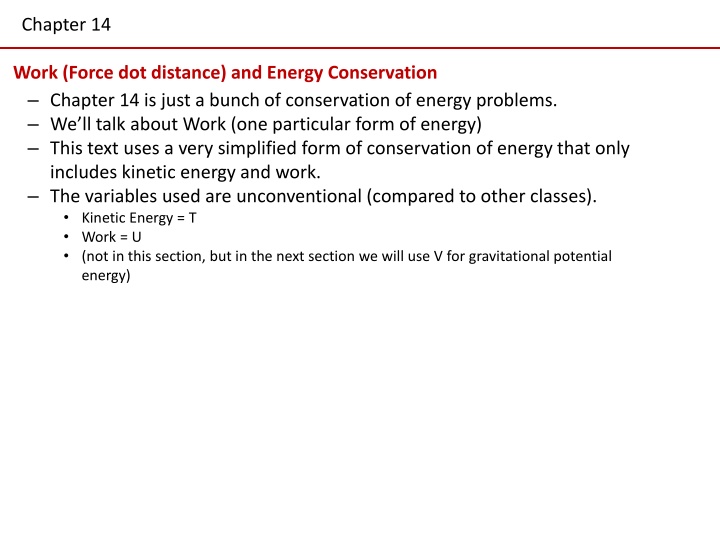
Work, Force, Distance, and Energy Conservation
Explore the principles of work, force, distance, and energy conservation in Chapter 14. Learn about the work of a force, variable force, constant force, weight, and spring force. Dive into the Principle of Work and Energy to understand the relationship between kinetic energy and work in this simplified explanation of energy conservation.
Download Presentation

Please find below an Image/Link to download the presentation.
The content on the website is provided AS IS for your information and personal use only. It may not be sold, licensed, or shared on other websites without obtaining consent from the author. If you encounter any issues during the download, it is possible that the publisher has removed the file from their server.
You are allowed to download the files provided on this website for personal or commercial use, subject to the condition that they are used lawfully. All files are the property of their respective owners.
The content on the website is provided AS IS for your information and personal use only. It may not be sold, licensed, or shared on other websites without obtaining consent from the author.
E N D
Presentation Transcript
Chapter 14 Work (Force dot distance) and Energy Conservation Chapter 14 is just a bunch of conservation of energy problems. We ll talk about Work (one particular form of energy) This text uses a very simplified form of conservation of energy that only includes kinetic energy and work. The variables used are unconventional (compared to other classes). Kinetic Energy = T Work = U (not in this section, but in the next section we will use V for gravitational potential energy)
14.1 Work of a Force Work of a Variable Force A force does work on a particle only when the particle undergoes a displacement in the direction of the force. r s 2 2 = = rF r cos EQ 14-1 U d F ds 1 2 s 1 1 The area under the graph of force along the path vs. displacement.
14.1 Work of a Force Work of a Constant Force Moving Along a Straight Line If the force has a constant magnitude and acts at a constant angle, the work can be found according to: s 2 = cos U F ds 1 2 c s 1 = cos ( ) EQ 1 4-2 U F s s 1 2 2 1 c
14.1 Work of a Force Work of a Weight The work of a weight is equal to the magnitude of the particle s weight times its vertical displacement. Because weight acts downward and vertical displacement is positive, the work of a weight is negative. r ( ) ( ) 2 = = + + F r j i j k U d W dx dy dz 1 2 r 1 y ( ) 2 = Wdy = W y y 2 1 y 1 = W y EQ 14-3 U 1 2
14.1 Work of a Force Work of a Spring Force Because the force of a spring is proportional to and in the opposite direction of its displacement, the work of a spring is: s s 2 2 = = U F ds ksds 1 2 s s s 1 1 = 1 2 1 2 ( ) EQ 14-4 U ks ks 2 2 2 1 1 2 A mistake in sign can be avoided by noting the direction of the spring force acting on the particle with respect to the displacement of the particle.
14.2 Principle of Work and Energy Principle of Work and Energy The equation of motion of a particle subjected to a system of external forces along the direction tangential to the path of motion is: = F ma t t ( ) = Furthermore, the acceleration is defined as: t a v dv ds t Fds mvdv = Combining the above equations gives: And by integrating both sides we find the Principle of Work and Energy: s s 2 2 = = 1 2 1 2 Fds mvdv mv mv 2 2 2 1 t s s 1 1 = 1 2 1 2 U mv mv 2 2 2 1 1 2 State 2 kinetic energy + = 2 EQ 14-7 T T U State 1 kinetic energy 1 2 1 sum of work from state 1 to 2
14.3 Principle of Work and Energy Principle of Work and Energy for a System of Particles The principle of work and energy can be extended to include a system of particles. In this case, the initial kinetic energy of the system plus the work done by all external and internal forces acting on the system is equal to the final kinetic energy of the system. + = T U T 1 2 1 2 Work of Friction Cause by Sliding A special case exists where a body slides over the surface of another body in the presence of friction. In the case where the applied force just balances the friction force, we would expect: + = 1 2 1 2 mv Ps Ns mv 2 2 k In reality, the work of the resultant friction force represents both the external work of friction and internal work converted into various forms of internal energy, such as heat.
In-Class Practice Problem 1 Draw a FDB (If you re trying to move the crate, don t push in the downward direction!) Solve for normal force Put friction force in correct direction Find Work terms (noting +/- sign) Apply conservation of energy equation
In-Class Practice Problem 1 Here s is the distance in the direction of motion (horizontal to the left is positive)
In-Class Practice Problem 2 First Question: Conservation of energy to find height (assume no friction/losses) Second Question: Draw a FDB of person (note the orientation .gravity acting on person, weight, needs to be included) Calculate acceleration around a curve
In-Class Practice Problem 3 Work = Force dot distance. In this section your textbook considers a change in potential energy one of the work terms (weight dot change in height) Draw a FDB of block Solve for the velocity as a function of angle Find out where the normal force = zero
In-Class Practice Problem 3 This is one you ll probably have to think about. Can you create a function that uses sine instead? Speed as a function of theta
In-Class Practice Problem 3 Normal acceleration as a function of theta Normal force as a function of theta
In-Class Practice Problem 3 Still struggling with this one? Try: Give r a value (r = 10 ft) Give an initial velocity (v = 2 ft/sec) Solve the problem with these known values rather than symbolically
In-Class Practice Problem 4 This is just like problem 4-5, only doing it in a few places.
In-Class Practice Problem 4 At point B
In-Class Practice Problem 4 At point C



